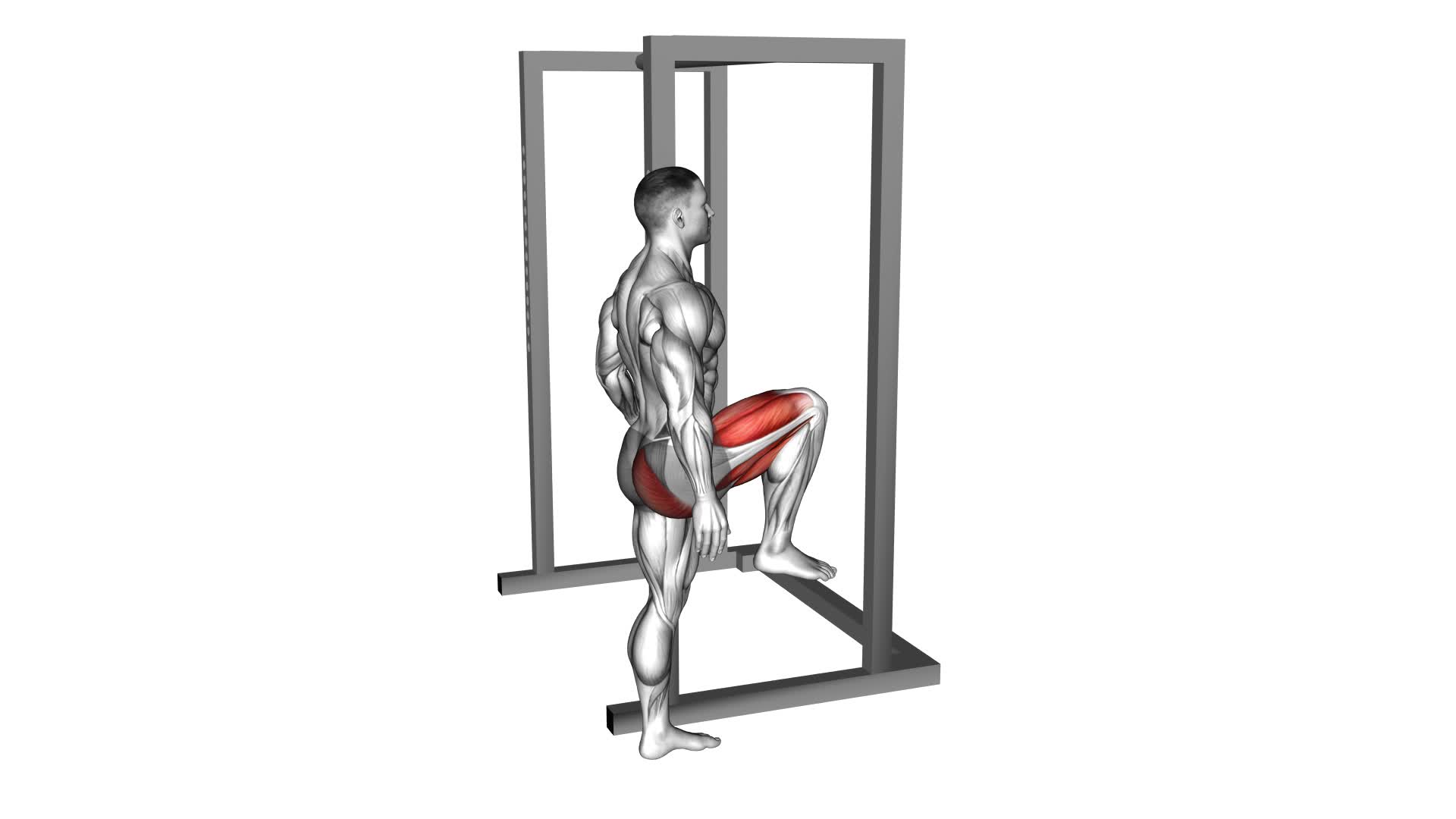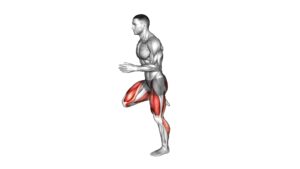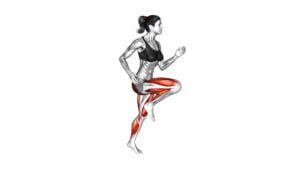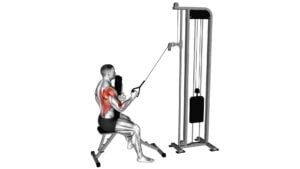Standing Single Leg High Knee to Butt Kick With Support – Video Exercise Guide & Tips

Get ready to elevate your workout with the Standing Single Leg High Knee to Butt Kick With Support.
Watch This Exercise Video
This exercise targets your leg muscles while improving balance and stability.
In this video exercise guide, you'll learn the proper technique, common mistakes to avoid, and tips for getting the most out of this exercise.
So grab a support and get ready to kick it up a notch!
Key Takeaways
- Targets leg muscles, core muscles, glutes, hamstrings, and quadriceps
- Improves balance and stability
- Utilizes balance techniques and proper form
- Incorporates support and resistance for modifications and progressions
Benefits of Standing Single Leg High Knee to Butt Kick With Support
You will experience improved balance and stability when performing the Standing Single Leg High Knee to Butt Kick With Support exercise. This exercise targets your lower body muscles, particularly your glutes, hamstrings, and quadriceps. By standing on one leg and elevating the other, you challenge your body's balance techniques. This helps to strengthen your core muscles and improve overall stability.
To perform this exercise, start by standing upright with your feet hip-width apart. Lift one leg off the ground and bring your knee up towards your chest, while keeping your core engaged. Then, extend your leg back and kick your heel towards your butt. As you do this, make sure to maintain a straight posture and avoid leaning forward.
There are variations and modifications you can make to suit your fitness level and goals. If you're a beginner, you can use a wall or chair for support while performing the exercise. This will help you maintain balance and stability. As you progress, you can increase the height of your kick or add resistance by using ankle weights.
Proper Technique for Standing Single Leg High Knee to Butt Kick With Support
To perform the Standing Single Leg High Knee to Butt Kick With Support exercise properly, it's important to focus on balance and stability techniques. Keep your core engaged, maintain a straight posture, and use your supporting leg to stabilize yourself throughout the movement.
Additionally, be mindful of common mistakes such as leaning forward or using momentum to lift your leg, as this can compromise the effectiveness of the exercise.
Balance and Stability Techniques
Achieving balance and stability during the standing single leg high knee to butt kick with support exercise requires proper form and control. To help you improve your balance and stability, consider incorporating the following techniques into your routine:
- Engage your core muscles: Activate your abdominal and back muscles to provide a stable base for your body.
- Maintain a neutral spine: Keep your back straight and avoid leaning forward or backward to prevent strain on your lower back.
- Focus on your standing leg: Distribute your weight evenly through your foot and engage the muscles in your leg to maintain stability.
- Use a support: If needed, use a wall or a chair for support until you can perform the exercise without assistance.
By implementing these techniques, you can enhance your balance and stability during the standing single leg high knee to butt kick with support exercise.
Now, let's move on to the next section and learn about common mistakes to avoid.
Common Mistakes to Avoid
To maintain proper technique for the standing single leg high knee to butt kick with support exercise, it's important to be aware of common mistakes that should be avoided.
One common mistake isn't utilizing balance techniques. It's crucial to engage your core and maintain a stable stance throughout the exercise.
Another mistake to avoid isn't focusing on proper form. Make sure to bring your knee up towards your chest and then kick your heel towards your glutes, keeping a controlled and smooth motion.
Additionally, be mindful of not leaning forward or backward excessively, as this can throw off your balance and compromise the effectiveness of the exercise.
Common Mistakes to Avoid During Standing Single Leg High Knee to Butt Kick With Support
To avoid common mistakes during the Standing Single Leg High Knee to Butt Kick With Support exercise, focus on maintaining proper form and engaging your core muscles throughout the movement. This won't only help you perform the exercise correctly, but also maximize its benefits for balance improvement and muscle activation.
Here are some common mistakes to avoid:
- Losing balance: Make sure to keep your standing leg stable and grounded throughout the exercise. Shift your weight onto the supporting leg and avoid leaning or swaying.
- Not engaging core muscles: To maintain stability and control, it's crucial to engage your core muscles. Keep your abdominal muscles tight and draw your belly button towards your spine.
- *Emotional appeal:*
- Frustration: Don't let frustration take over if you find it challenging at first. Practice and consistency will help you improve.
- Motivation: Remember that by avoiding these mistakes, you're setting yourself up for success and getting closer to your fitness goals.
Equipment Needed for Standing Single Leg High Knee to Butt Kick With Support
To perform the Standing Single Leg High Knee to Butt Kick With Support exercise, you'll need a sturdy support or wall to lean against. This will provide stability and help maintain proper form throughout the exercise.
If you don't have access to a support, you can use a chair or any other stable object that allows you to maintain balance while performing the exercise.
Necessary Equipment for Exercise
You will need equipment for the Standing Single Leg High Knee to Butt Kick With Support exercise. Here are the necessary items:
- A sturdy support or wall: This will provide stability and balance during the exercise, reducing the risk of falls or injuries.
- Comfortable workout attire and athletic shoes: Wearing proper attire and footwear ensures that you can move freely and safely during the exercise.
Alternative exercises:
- Standing March: If you're unable to perform the Standing Single Leg High Knee to Butt Kick With Support exercise, you can try the Standing March. This exercise involves lifting your knees towards your chest while standing in place.
- Seated Knee Raises: If standing exercises aren't suitable for you, you can perform seated knee raises. Sit on a chair and lift one knee towards your chest, then lower it back down. Repeat with the other leg.
Safety precautions:
- Consult with a healthcare professional before starting any new exercise routine.
- Start with a warm-up and stretch to prepare your muscles.
- Listen to your body and stop if you experience any pain or discomfort.
- Gradually increase the intensity and duration of the exercise over time.
Alternatives to Equipment
If you don't have the necessary equipment for the Standing Single Leg High Knee to Butt Kick With Support exercise, there are alternative options available.
Bodyweight exercises are a great way to work out at home without needing any specialized equipment.
For a similar lower body workout, you can try standing single leg knee raises and standing butt kicks separately.
To perform standing single leg knee raises, stand on one leg and lift your opposite knee up towards your chest, then lower it back down.
For standing butt kicks, stand on one leg and kick your opposite heel up towards your glutes, then lower it back down.
These exercises target the same muscle groups as the Standing Single Leg High Knee to Butt Kick With Support exercise and can be done without any equipment.
Modifications and Progressions for Standing Single Leg High Knee to Butt Kick With Support
How can you modify and progress the standing single leg high knee to butt kick with support exercise?
Here are some modifications and progressions to help you challenge yourself and continue to improve:
- Modifications:
- Decrease the height of the knee lift and butt kick: If you're finding it difficult to lift your knee high or kick your butt, start by reducing the range of motion. Focus on maintaining proper form and gradually increase the height as you get stronger.
- Use a support: If you're struggling with balance, hold onto a sturdy object like a wall or chair for support. This will help you stabilize yourself and perform the exercise with control.
- Progressions:
- Increase the speed: Once you feel comfortable with the exercise, try performing it at a faster pace. This will challenge your coordination and cardiovascular endurance.
- Add ankle weights: To further strengthen your leg muscles, you can incorporate ankle weights. Start with a light weight and gradually increase as you become stronger.
By modifying and progressing the standing single leg high knee to butt kick with support exercise, you can continue to challenge yourself and improve your strength, balance, and coordination.
Now, let's move on to some tips for getting the most out of this exercise.
Tips for Getting the Most Out of Standing Single Leg High Knee to Butt Kick With Support
To maximize your results with the standing single leg high knee to butt kick with support exercise, focus on maintaining proper form and gradually increase the intensity. Here are some tips to help you get the most out of this exercise:
- Getting started:
- Start by standing tall with your feet hip-width apart.
- Engage your core and find your balance on one leg.
- Place your hands on a stable surface for support, such as a chair or wall.
- Proper form:
- As you lift your knee to your chest, make sure to keep your back straight and your shoulders relaxed.
- Engage your glutes and hamstrings to kick your heel towards your butt, focusing on the contraction in the back of your leg.
- Gradually increase intensity:
- Once you have mastered the basic form, you can increase the intensity by adding resistance.
- You can use ankle weights or resistance bands to challenge your muscles further.
- Variations and modifications:
- If you find it difficult to maintain balance on one leg, you can start by performing the exercise with both feet on the ground.
- As you progress, gradually transition to the single leg version.
Remember to listen to your body and start at a level that's appropriate for your fitness level. As with any exercise, it's important to warm up before performing the standing single leg high knee to butt kick with support and to cool down afterwards.
Frequently Asked Questions
What Are the Benefits of Incorporating the Standing Single Leg High Knee to Butt Kick With Support Exercise Into My Workout Routine?
Incorporating the standing single leg high knee to butt kick with support exercise into your workout routine has many benefits. It helps improve balance, stability, and coordination while targeting the glutes, hamstrings, and hip flexors.
This exercise can also enhance lower body strength and flexibility. If you don't have equipment, you can modify it by performing the exercise without support, using a chair or wall for balance.
It's a great addition to your routine for overall lower body conditioning.
Can This Exercise Help Improve Balance and Stability?
Yes, incorporating the Standing Single Leg High Knee to Butt Kick with Support exercise into your workout routine can help improve balance and stability.
By focusing on one leg at a time, this exercise challenges your coordination and enhances proprioception, which is your body's ability to sense its position in space.
It strengthens the muscles in your legs and core, helping you maintain stability and prevent falls.
Is the Standing Single Leg High Knee to Butt Kick With Support Suitable for Beginners?
Yes, the standing single leg high knee to butt kick with support is suitable for beginners. This exercise can help improve balance and stability, and there are modifications available for beginners.
If you find it challenging, you can start by performing the exercise with both feet on the ground or by using a chair for support.
As you progress, you can gradually increase the difficulty level or try alternative exercises to further challenge yourself.
How Can I Modify This Exercise if I Don't Have Access to Any Equipment?
If you don't have access to any equipment, there are still ways to modify the standing single leg high knee to butt kick exercise.
You can try performing the exercise without support by balancing on one leg and bringing your knee up as high as possible, then kicking your butt with your heel.
Another alternative is to perform the exercise with your back against a wall for added stability.
Remember to maintain proper form and engage your core throughout the movement.
Are There Any Potential Risks or Precautions I Should Be Aware of Before Attempting the Standing Single Leg High Knee to Butt Kick With Support Exercise?
Before attempting the standing single leg high knee to butt kick with support exercise, it's important to be aware of potential risks and take necessary precautions. This exercise can strain your muscles and joints if not performed correctly or if you push yourself too hard.
It's recommended to start with a lower intensity and gradually increase as your body gets accustomed to the movement. If you don't have access to equipment, you can modify this exercise by using a wall or chair for support.
Conclusion
In conclusion, the Standing Single Leg High Knee to Butt Kick with Support is a beneficial exercise for improving balance, strength, and flexibility in the lower body.
By following proper technique and avoiding common mistakes, you can maximize the effectiveness of this exercise.
With minimal equipment needed, it can be easily modified or progressed to suit your fitness level.
Remember to focus on proper form and engage your core for optimal results.
Incorporate this exercise into your routine for a challenging and effective workout.

Author
Years ago, the spark of my life’s passion ignited in my mind the moment I stepped into the local gym for the first time. The inaugural bead of perspiration, the initial endeavor, the very first surge of endorphins, and a sense of pride that washed over me post-workout marked the beginning of my deep-seated interest in strength sports, fitness, and sports nutrition. This very curiosity blossomed rapidly into a profound fascination, propelling me to earn a Master’s degree in Physical Education from the Academy of Physical Education in Krakow, followed by a Sports Manager diploma from the Jagiellonian University. My journey of growth led me to gain more specialized qualifications, such as being a certified personal trainer with a focus on sports dietetics, a lifeguard, and an instructor for wellness and corrective gymnastics. Theoretical knowledge paired seamlessly with practical experience, reinforcing my belief that the transformation of individuals under my guidance was also a reflection of my personal growth. This belief holds true even today. Each day, I strive to push the boundaries and explore new realms. These realms gently elevate me to greater heights. The unique combination of passion for my field and the continuous quest for growth fuels my drive to break new ground.







